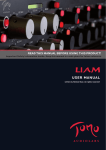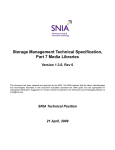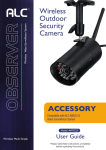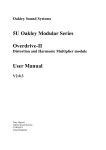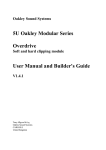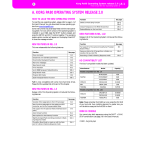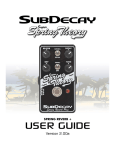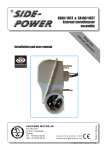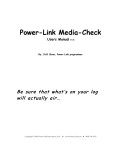Download USERS MANUAL - Empirical Labs Inc.
Transcript
USERS MANUAL FULL ANALOG TA P E S I M U L AT O R & OPTIMIZER WITH KNEE COMPRESSION INDEX 1 Features & Specs 2 What Is The Fatso? 2 Using for the First Time 3-5 Example Settings 6 The Compressor - Four Types 7-8 Recall Sheet 9 The Saturation & Warmth Circuits 10 The Tranny 10 Block Diagram 11 Basic Wiring and Stereo Linking 12 Troubleshooting 12 Fuse Replacement, AC Voltage Select 13 User Notes 14 Customer Comments 15 Warranty BACK TO TABLE OF CONTENTS Features Soft clip features modeled after broadband tape saturation. WITHOUT THE NOISE! Smooth clipping up to 20% THD. User programmable high frequency saturation, simulating the "softening" for which analog tape and phonographs are known. This is the "Warmth" control on FATSO. Switchable transformer circuits, which can add the musical artifacts generated by classic devices like NEVE, API, etc. These artifacts include frequency "rounding", low order clipping & intermodular distortion, transient clipping... and some other very musical non-linearities. Four compression modes - One for tracking, one general purpose, one "bus" compressor, and SPANK (see below). All LINKABLE! Classic knee compressor sound that really grabs. SPANK!- An additional limiter that musically smashes the dynamic range, and can be used to stop clipping before digital recorders. There is a subtle knee followed by hard limiting. Huge "DISTRESSOR" knobs with high resolution numbering - For easy readability and repeatable settings. They also go to 10 1/2 . Distortion indicator lights - A 0 VU LED and a "Pinned" (5%) LED. No hard clipping until a few dB past "Pinned". Sidechain output and input for eq-ing control signals. Locked, calibrated, output level - Allows speed in setting tape and live mix levels. Foolproof operation - it's almost impossible to get a bad sound. Single height and light weight - Two channels of classic sound in a small, extremely reliable package. Discrete and integrated combination - the best of speed/linearity with repeatability. Hand tested & selected components. All metal film and Roederstein resistors in the audio path - top quality components, most being high temperature military spec parts. Switchable 115/230 volt operation - Extra fuse provided inside unit. True bypass - Know what it's really doing. All contacts doubled up for maximum reliability. No internal audio connectors. XLR and 1/4" phone ins and outs - XLR fully balanced, transformerless design, pin 2 hot. Changeable by user to pin 3 hot. No internal connectors, high reliability parts and military grade switches and relays. Three year unlimited warranty. Interface and features found nowhere else. Allows processing not readily available in our current digital domain. New life for analog processing! Hand wired, calibrated in USA. Shipping weight 13.25Lbs. Specs ♦ ♦ Freq. Response is 2 Hz to 60 kHz in clean audio mode (+0, -3 dB). Dynamic Range - 110 dB from maximum output (20%THDsoft clipping) to minimum output. ♦ ♦ ♦ Distortion Ranges between .06% and 20% depending on mode and settings. DC coupled Input and Outputs - High quality audio caps used internally. Compressor Time Constants - Attack range 1mS - 200mS. Release range .05 sec to 3.5 ♦ Power Consumption – 35 Watts Max typically. Greater than 100 dB signal to noise. seconds. Attack and Releases are fixed by the compression type selected. .3A @115. Empirical Labs - Something Old, Something New 1 BACK TO TABLE OF CONTENTS What is The Fatso? (Hmm, Not such an easy question!) The EL7 FATSO is a modern digitally controlled analog device that offers many of the "musical non-linearities" exhibited by the older tube, class A discrete, and magnetic tape mediums. This two channel audio processor will musically integrate frequencies and transients and increase the apparant volume without actual increase in peak levels. In addition, two channels of famous Empirical Labs compression are provided. There are several compressor "types" with fixed attacks and releases (if you want a fully controllable compressor, you will need the Empirical Labs Distressor!). Users can enhance & soften the sound of mediums such as modular digital multitracks (MDM's), HD recorders, Dat recorders, Ram Recorders etc. Mixdown engineers will have an option not to use bulky, expensive, (and often flaky) analog tape recorders to get the warmth and sweet high end they've come to rely on for so many decades. Owners of Adats, MDM's, RAM and modern hard disk recorders can finally put a stop to complaints about the "coldness" and "brittle edge" of their mixes and instruments with the "rounded" and "musically non linear elements" of vintage analog. Finally, audiophiles can bring back the warmth and cuddly sound of LP's and tapes to their CD players, and other digital reproduction mediums. Fatso's Four Types of Processing (See next page for detailed description) 1) Harmonic Generation and Soft Clipper (Distortion generation) 2) High Frequency Saturation - WARMTH! 3) Transformer & Tape Head Emulation 4) Classic Knee Compression - Empirical Labs Style! Using the Fatso for the first time Hookup is straightforward. Either the XLR's or phone jacks can be used. In relation to the phone jack tips, pin 2 is wired "hot" on the XLR's. But if you're using the XLR's in and out, it doesn't matter which pin is hot, as long as you're cabling is in phase. If you use a single ended XLR output, leave unused pin floating! Connecting all input pins is preferred, but the unit will operate fine if unused pins aren't tied to ground. Hookup directions are also located on the rear panel of unit, near the connectors. See page 11 for more detailed wiring instructions. It’s advisable to mount in a cool rack position, as the Fatso Jr. tends to run quite warm. Fatso is ideal for sources that sound brittle, bright, or pointy or have excessive dynamic range. You will probably find so many uses for the Fatso as we did, but ...let's just go over a couple quick scenarios here. Let's say you have a vocal either live or in the studio that seems lifeless or needs presence and intensity. First lets set the compressor up. In fact you should always set the compressor up first because it interacts with the other processors in the Fatso. For excessively dynamic vocals I would go right to the TRACKING compressor "type" with both the green and yellow LEDs lit in the compressor select area. Adjust the input til you get 5 dB of GR to start with and adjust the output knob until there's not a great difference between the bypassed and un-bypassed levels. Remember the Bypass switch is multiplexed and to cycle in and out of bypass, click twice quickly. Next decide if the vocal has a brittle edge on the top end. If so, you have two other ways to soften. The most subtle is the Tranny which engages a specially tweeked transformer circuit that enhances the midrange while softening extreme transients and fattens 200 hz and below. That may not be what you need on vocs tho. Try the Warmth control for less subtle high end softening. This circuit is a wierd dynamic filter not too far removed from de-essing except it is above most sibilant freqs and works on a different principle and filter type. (...ok, so it is far removed!). This circuit is really useful on vocs that are bright or have 10KHz and above boosted heavily with EQ. In fact warmth is really useful used in conjunction with high freq eq boost, as it will only grab the parts that are excessively bright or "plasticky" and get out of the way in less than a millisecond. Use it as an EQ tamer. As you progress from 1 - 7 on the warmth control, more and more high freguencies will be "grabbed" and eventually you will start muffling the signal. DON'T DO THAT! Be very careful not to overuse the warmth control... 1 - 5 dB of Warmth is a lot. By now that distant, thin, vocal should be HOT and in your face. When using the compressor and warmth together, remember the interaction. Apply this same type of thinking to other sources/instruments. Don't be afraid to use the warmth without any other processing, or just the compressor, or just the Tranny (to fatten low end). Also remember the unit is always passing the signal through the saturation circuits, with no LED's on whatsoever. Don't feel like you have to use all the processing within the unit because that will surely get you in trouble, sooner than later. SEE EXAMPLE SETTINGS ON NEXT PAGE. 2 BACK TO TABLE OF CONTENTS EXAMPLE SETTINGS The Fatso was designed essentially to integrate frequencies in a musical manner and provide some fool proof vintage sounding compression. Generally, it is difficult to make the unit sound unnatural due to its vintage topology. But it is possible to "overdo" things! Let's go over the four types of processing the Fatso provides, and describe what they do and generally when they would be used. Fatso's Four Types of Processing 1) Harmonic Generation and Soft clipper - Basically this is a distortion generator. Anytime you pass a signal thru the Fatso, it passes thru this part except in bypass. This processing is useful to softly but instantly clip peaks and transients, allowing more average level. 2) High Frequency Saturation - WARMTH! This circuit is meant to simulate the softening of the high end that occurs with analog tape. Basically as the warmth is increased, overly bright signals and transients will be quickly attenuated. The time constants are very nearly instant, so the high freqs return very quickly after a loud burst. 3) Transformer & Tape Head Emulation - This is a simulation of the effect of input and output transformers of older devices and adds the low frequency harmonics that characterize analog tape. This is extremely useful on pure low frequency type tones that don't cut thru small speakers. It adds upper "warm" harmonics to frequencies below 150Hz, especially those even lower such as 40Hz, the low string on a bass guitar, helping it to cut thru on smaller speakers. 4) Classic Knee Compression - Empirical Labs Style! This is your typical automatic leveling device that you find used on just about every instrument and vocal track, as well as on the overall buss. Only its Empirical Labs compression - smooth sweet but in your face! (Reminds me of an old girl friend) See the compression guide on page 6 for description of the 4 compressor types. CD Player & Buss Fattening - This was almost the original intent of the Fatso. That is, it was a two-channel device that could make a stereo digital signal sound "analog" and integrate the different frequencies in a musical way. It could be used as a stereo device thru which one could mix or transfer to or from a digital medium to make it sound very analog tape-like. For those who aren't used to the Jargon... A BUSS is usually a pair of channels that have pre mixed instruments or stereo music on them. The Left & Right outputs of your CD player could be considered a 2 channel buss. In the recording studio, it is more often applied to the final left and right channel mix, or to something such as all the drums mixed down to 2 tracks (a "submix), so that instead of moving 12 faders at once to move drums up or down, you only have to grab those two. MIXDOWN PRE PROCESSOR - Again, one of the original intended uses. By placing the Fatso immediately before a digital mixdown recorder such as a DAT, CD, HD, or RAM recorder, the recording engineer should be able to get the sweet high end and low frequency fatness that he could mixing to an analog tape recorder. Compression should usually be the Buss type, use the warmth to soften the high end and the Tranny to add some edge and warm harmonics to the Low frequencies. CD PLAYERS & Other Digital Recorders - Take the output of the CD player into the Fatso input. Our first goal is to make that CD player have the warmth and softness of the old tape recorders and records. If you were going to use compression, set it up first since it interacts with the other settings. But for now let's not use any compression here. First adjust unity gain thru the Fatso. Set the input until the 0VU LED glows on peaks from time to time. This will set up the saturation to emulate some nominal tape like distortion. Next if you want the low end to have more bite, the tranny may be useful but for most digital recordings, try messing with the warmth control. Allow 1 - 5 dB of warmth to occur on peaks. When AB'ing it to the original signal, a new softness and fatness will be noticed immediately. You will be able to listen to things a little louder than usual. DJ level controller and master PUMP device - Place the Fatso before your power amps or at the output of your DJ mixer to level out or fatten up the whole show. The Buss compressor can level out volume differences while keeping the "smack" intact. You can then add some top EQ and have the warmth hold back the brittle edges. The Tranny may help on smaller systems to get the low freqs clearer but if you have lots of subsonic info... you may want to keep Tranny out of line since it will roll off the exceptionally low low stuff. Vocals - There are so many ways to use Fatso here. During tracking, turn on the Tracking Compressor which lites the green and yellow LED in the compressor area. This is a pretty safe LN1176 Type knee compressor with a pretty quick attack and release. That might be all you need! Using up to 10 dB of compression should be fine with really dynamic vocs. Alternately, you can try one of the other compressor types, even SPANK to grab occasional peaks and then quickly get out of the way. 3 t h BACK TO TABLE OF CONTENTS EXAMPLE SETTINGS (part 2) Troubleshooting If the top end is too sizzly or spitty, you can try the warmth control, maybe adding up to 6dB of warmth on the peaks. This is not a de-essing function since it affects freqs above the most trouble-some sibilant freqs,forgets nonetheless, may when find it helps take some the- hissy sound out of a source. * Unit whereyou it was power was shutofoff Non Volatile memory cap has become Tranny may be some useful other on exceptionally low vocals as occurred. it will warmContact the low tones to some It will defective, or possibly type of logic failure has the factory for degree. servicing. alsosign roll the super subs off but generally, Tranny will not radically affect vocal * No of life - Check power cord for firm connection. If still no life most unplug unitsources. and open top cover byVarious removing all top screws and check fuse toward rear next to transformer. If it is blown, pry it out and Instruments replace it with extra fuse provided in fuse holder toward front of chassis. If fuse is OK, make sure your - Fatso is gonna betoreally useful is notoriously to round out and clarify sometimes, Bassselect Voltage switch is set current wallhere. outletBass voltage (115, 230hard VAC). but the Fatsoblowing has many ways- to help. internal First, if voltage a low bass toneswitch is too for pure and sine-wave-like, it will "fall off" * Unit keeps fuses Check select proper settings (115/230). on small speakers. thisor wepower mean,supply it will not be audible because mostthere of theisbass frequencies below Otherwise, suspect aBy short problem. Try to make sure nothing trapped are under the range of the speakers. the PC board, shorting to the metal case. Attentive visual inspection is still the most effective The Tranny is available. the solution,See combined troubleshooting tool below.with the saturator circuits. These will generate upper harmonics that will behot musically These harmonics be mount reproduced on small * Unit runs – Leaverelated. a space above or belowwill it, or in cooler rack.speakers and the human ear (and mind), will psycho-acoustically fill in the lower fundamental! Great on direct bass. * Unit is on but not doing anything - The unit may be bypassed or operating subtly. If bypassed, you The Fatso compressors are fabulous on bass too. The buss compressor is good for an already need to press the "BY-PASS" button so red LED goes off. The input and output levels should always compressed or very evenly played bass, since it will leave the transients and remaining dynamics in. It will affect it unless bypassed also allow you to use varying amounts of grunge since it is such a gentle compressor that wont really nail * Bargraph shows gain reduction but very little or none is actually occurring -The unit is possibly the bass level in place. Just by turning the input up, one can add or remove distortion. The GP is another severely out of adjustment. We use very stable trim pots and high quality components, but it is possible compressor that may allow the dynamics to come thru but due to the long release, excessive pops or that long term component aging or failure may require factory re-calibration. Also, dampness or plucks may create "holes" in an overly dynamic bass part. The Tracking compressor is a favorite again for something spilled into the Fatso can cause this phenomenon. At present you will have to return the bass (both the green and yellow LED lit). It is the most Distressor-like compressor in the Fatso with a fast FATSO to factory for re-calibration. In the future there will be local dealers and/or service centers to attack and release, along with a smooth knee. SPANK is useful for a more aggressive level control on help. Bass. * Distorted output - If there is severe, un-musical distortion, chances are you're hard clipping. Check As you can see, there are lots of options here. The warmth control may be useful for some trebly, that the output cable is properly wired and any unused output pins (2 or 3) on XLR are floating (left over eq'd basses, but generally it may find limited use here. Again, watch for over smashing or grunging. unconnected). Shorting an output notto harm unitcannot but can show up as distortion in the output Caution should be observed if youpin arewill going tape.theYou un-distort! driver. The distortion this unit is meant to impart is harmonic and should not sound like crackly Elec. guitar - Ahard wideclipping. range of Ifsettings can be used. Toon, getyou rid of edgy attacks, quick attack, distortion caused by the pinned LED stays must turn down use the the input! fastoutput releaselevel of the- tracking compressor. If thegetting guitar is combined theare * No Make sure there is audio totoo thedynamic, unit, andthe thatcompressor the input and output with levels saturator turned up. and tranny circuits may be the answer. Sometimes the guitar just needs a touch of fatness without losing try thepumps buss compressor to maintain transients. Watchcompressor over warming guitars with the * Unit pops or attack, unnaturally with low frequencies Try a different TYPE. saturators and the warmth circuits. range Crunchy guitars whichisare full ofthan harmonics, sensitiveif to * Unit seems noisy - The dynamic of the FATSO greater CD (16are bit)notoriously quality. However, tonal Over a saturating or warming canistake awayup thealong claritywith or bite to cut If thru. you arechanges. compressing noisy signal, the noise pushed the needed soft signals. youOther havetimes, 20 it'sofjust what's needed the guitar be has louder in dB a mix andthe stay out of thewill waybeofraised vocs because upper, dB gain reduction ontoalet room mic that a 90 S/N, noise floor 20 dB inthe quiet spiky,bringing harmonics flattened a bit. When arethe dealing withisan occasional peaky guitar where without certain areas, theare noise floor up to 70 dB. you Since FATSO capable of lots of compression chords orunnatural, notes takeyou your head off,bring the dynamic action the warmthRemember control can your be sooooo Don't sounding can often hiss levels up of undesirably. currentuseful. input level, overdue this though, especially tracking! and then ensure that the noise iswhile coming from outside the unit by turning the input knob off (to 0). All The Tranny may also seem to add midrange focus because of the harmonic generation on noise should disappear. Tryactually gating before compressing. the low and low mid freqs. To smooth out solos, try the tracking compressor with tranny and warmth. REMEMBER TO SET UP COMPRESSOR FIRST. The warmth really interacts with the compressor. Plucked Instruments & Acoustic Guitar - Plucked instruments can benefit greatly from Changing the fuse the Fatso's processing. Back in 1998, the Fatso was taken to Greece and used on many very troublesome Caution: Always unplug unit before removing cover! ethnic plucked instruments. At Grammys, a club in ATHENS, some bizarre FATSO behavior was Pull out the power plugwhen fromthe theextremely AC outlet,transient open unit, and ensure fuse closest to rear of the unit iscircuits. immediately noticed, acoustic instruments "swamped" several internal blown. (Note: The needed fuse closer to theknee frontwith panel is a"sponge" spare fuse andattack. is not The connected anything). (green The compressor a heavier more in the trackingtocompressor Gently pry out oneon) endwas of the fuse and it withCompressor extra fuse provided and yellow LEDs tweaked first.then The the fastother, attackreplacing of the Tracking can helpnear get abattery "glassy" holder in front of unit. A small may be helpful. Before putting cover in unit,ofkeeping full sound since the pick noise screwdriver will be attenuated and the sustain lengthened. Alsoon, theplug threshold the hands outcircuits of the were box, ensure the fuse blow again,picked indicating a possibly more serious warmth loweredthat so they coulddoesn't grab the transient edges easier. This allowed a solo problem (seetotroubleshooting). If OK, unplug unit,hurting. screw down top cover and return the unit to normal instrument be louder without the sharp attacks Sometimes you want to keep the dynamic plucked instrument butused needattofactory. smooth out use. Any fuse from .3 may to .6A should be safe, but .3Arange (1/3A)ofisawhat is specified and just the spare hard front of the attack. Warmth processing is perfect thefuse warmth until you Replace fuseedge in front if available. We went to the expense tohere. keepAdjust an extra inside... you have a smoother, should too. more natural sound - usually 3 - 10 dB of HF attenuation is enough. In addition to your normal monitoring levels, listen very softly, and very loudly to the adjusted track to make sure it isn't too dull, or still in need of "softening". Acoustic guitars can be so creamy. Many times you will have an acoustic part that is very even and Changing the voltage forit230 or 115 operation unplugging thefor unit and removing tophe you can nicely brighten up with a top end EQ also (highinvolves frequencies)..... except that one part where cover. Inside it! onUse the right (as thecontrol front oftothe unit faces you),brash is a switch 1151or on its really bangs the Warmth grab those clangy freqs. with Usually - 5230V dB isshowing enough but on face. desired by sliding switch until it indicates that voltage and done. reallySelect brittle the parts,10 - 15voltage dB on peaks maythe be ok on extreme peaks. Again don't over doyou're it, especially Replace cover and screws. during tracking. Listen really softly and really loudly to test evenness. Line Voltage Select 124 BACK TO TABLE OF CONTENTS EXAMPLE SETTINGS (part 3) Piano/Keys - Acoustic pianos often need less attack & more sustain to fit into a mix, but there are millions of exceptions. As far as the compression part...Bruce Hornsbyish pianos are often real or samples of real pianos with medium attack and medium release, that achieve a "bite" followed by sustained body. If you find the Buss type compressor a bit gentle and too hot, and distorting some of the peaks, try the Tracking Compressor with a fast release etc. The GP type compressor may work depending on how even the piano part is. If you have a dense mix and really need to make it take up a finite spot in the mix - go for the SPANK. This will slap the dynamic range down smoothly and quickly. It won't be an unfamiliar sound. Old Beatle records started using drastic amounts of compression to keep a piano sitting inside a busy arrangement. The saturator or soft clip part of the Fatso will be very useful also on piano and keys. Pianos and synths can have quite a peaky transient and the instantaneous nature of the saturator can often give you 6 db more peak headroom before your ear detects clipping. Synthesizers and samplers can benefit enormously since their envelope generators often create huge front peaks. The Warmth is also very useful here since it can soften the edges and also take care of the sharp trebly plastic edge without affecting the low frequency amplitude. Again watch over using the Warmth - you will find subtle use of the Fatso on keys to be extremely pleasing once they are dropped back in the mix. Often you can take a thin lifeless keyboard part and bring warmth and reality to it. Drums - Without any processing activated, the saturator which is always inline, will pack those peaks down smoothly giving you 3 - 6 dB more avg level. Distortion indicator LEDs, the O VU and the Pinned Red LED give you a good idea of what's going on. On percussion, peaks can lite up the RED Pinned LED without any nasty distortion, if they are short enough. Analog tape can not handle all the top end and will round out the sound... as will the FATSO's warmth processor and saturator. Don't use more than 5 - 10 dB of warmth on drums though.... or you are probably asking for a dull sound! Try putting digitally recorded tambourines etc through the Fatso and listen to the difference! That clacky front edge will become warm and easy to listen to - like the old analog tape and vinyl. Snares/Kicks/Toms - If you don't want to lose the basic sound, try setting the compressor to buss compressor first. This is a very gentle slow compressor that will leave the transients untouched. If there are areas with over eq'd highs or unnatural transients, get into the warmth processing. On snares that have had 8 - 10K added and have some really overly dynamic hits, 5 - 10 dB of warmth may fold the highs back (attenuate them) and smooth out the tonality. Use the High Frequency saturation that the warmth control provides on Kick drums that have the occasional clacky hit. The Tranny will be useful also. If the Kick drum is too boomy or too thumpy without enough clarity, the tranny will add some upper harmonics to the low freqs, while rolling off some of the subsonics. Overhead Mics - Also for over dynamic and brash cymbals, the warmth processing can be a real sweetener. To soften the edge of cymbals try Warmth on 4 or 5 setting and turn the input up to control the amount of warmth. Watch anything over 5 dB of warmth as this is really attenuating a lot of high end. But if it is just the front edge of the cymbals, it can be verrrrrry pleasing. Of course compression may be used but if it is, set it up first. Room mics - Again, the most gentle compressor for the room mics will be the BUSS compressor. However, radical room compression is currently in style! The Tracking compressor (Green and Yellow compressor LED's lit) will be useful over a wide range from 1 dB of GR to 10 dB depending on what you are going for, and what the tracks will allow. But for over the top treatment, try SPANK! The SPANK is not the NUKE of the Distressor yet it can add some of the same sustain and intense size to it. The bargraph can be run right offscale with the SPANK type compressor, and still be a very useful sound. Fifteen to twenty dB of compression is starting to have that John Bonham thing that the Distressor can do. Watch over heating the tracks though. Also, any loud cymbal playing will become annoying with lots of compression on the room mic. Sometimes it may help to feed a compressed room signal back to the drummer while tracking to give him a feel for balancing his cymbals and drums. Distortion device - The Fatso has very smooth clipping up until about 20%. Folks have already used the Fatso as a distortion box with great effectiveness and musicality. The warmth provides another way to roll off some harsh distortion grit as well, fattening up the lower harmonics. The Tranny will drastically distort sub frequencies below around 50Hz, but it is adding the 2nd and 3rd harmonics that sound very ballsy on those low tones. You may even find that plugging a guitar and bass directly in can work... although the impedance and gain structure are more suited to line level, or a Direct box output. Effects warmer - Try using the Fatso as a tape delay simulator by putting it after a digital delay. Turn the compression on BUSS compression and the warmth on a little. Use the Tranny to roll off subs and pump harmonics into the low frequencies. Similarly, try the Fatso on a digital reverb to simulate the plate reverb non-linearites and magnetic transducers. It works great. 5 BACK TO TABLE OF CONTENTS The Tranny The Compressor and its Ratios The Tranny is short for transformer. In the old days, to interconnect between audio components with Fatso cabling compressor or compressor as engineer we have used termed it, sets the threshold, the ratio (in low Each impedance (i.e. noise resistant),"TYPE" the audio transformers on the input and the standard sense isolate of the word) the attack, This was done to provide to set, yet outputs. Transformers two signals usingand wiredecay. coils wound close to each other,an buteasy not actually versatile group of never curves. There are essentially 4 discrete compressors with the fourth to be touching. They were that linear and often introduced saturation and LF distortion as able well as combined with the other three. Transformer design and use was an art (hats off to Rupert NEVE), changing the frequency response. and there were always tradeoffs. However, has been widely known thatTYPES: a good audio transformer THE FOUR itFATSO COMPRESSOR circuit do wonderful things to anratio audio signal. This was of our circuit. We is have 1. can Buss - very gentle 2:1 type with Slow attack and the fastgoal release. 1 -TRANNY 4 dB of compression usual for tried to emulate the desirable theorgood transformers in a consistent this compressor type. characteristics Very soft knee;of Five moreold dBinput/output of Buss compression is hitting it hard! musical in a selectable 2. way, G.P. and - General Purpose. fashion. A medium attack slow release type that sounds pretty invisible while able to o Many of the older transformers had certain lowrelease frequency characteristics that some our newer maintain a consistent RMS level. The slow will not pull things into your faceofunnaturally. and 3. moreTracking linear circuits and transformers have As1176 frequency goes down,isthe audiothat signal Compressor - when both top "overcome". LED's are lit, an type compressor enabled is great p gets moreforlike DC (i.e. slower moving). Transformers don't pass DC current thrumixdown. them, so strange tracking instruments and vocals during the recording process or during things happening audio goestype deeper. The addition of specifically harmonics designed and peaktosaturation along 4. start SPANK - This as is athe radical limiter compressor that was emulate the nice with frequency andofphase changes on the compressors low frequencies We foundQuite that awe the squeeze the older SSL talkback fromoccurs. the 70's & 80's. bitcould highercapture fidelity though, low frequency of large and now expensive older output transformers in a weird, internally as youeffects will notice. buffered switchable design.with any of the other 3 types of compressors, one really has 7 compressor types By combining SPANK Toratios), sum upalthough the musical results of aggressive our Tranny nature circuit, will there willtobedominate a little more edge in the midrange, (or the SPANK's tend when combined. The release and curve the super frequencies will have been itharmonically altered in and a way thatslows. allowsThis themrelease to sound of alllow types is logarithmic, meaning lets off quickly at first then curve is louder, even the peakscompressor are less than the original. Playback on small speakers will show an a big partthough of the FATSO's sound. improved audibility of low end from the result of the psycho-acoustically-pleasing distortion the Tranny Just what is areally soft interesting knee? adds. Something we noticed... even though fundamentals below 100Hz cannot show A "soft knee" is a compression first few dB of gain reduction at verygive lowyour ratios, up on the little speakers... because curve of the where naturalthe way a transformer saturates, theoccur harmonics increasing as the signal increases (gets This makes the onset of compression very earsgradually enough clues that your mind somehow fills in the louder). fundamental. If you have the time, try this hard to detect. usually extends forFatso, a few and dB and gradually flattens outtotoward a final ratio. All experiment... put 40The Hz knee sine wave tone into the match the Tranny level the bypassed the Fatso types have speaker. dominant A/B knees. Buss Type Compressor knee that can be level, then putcompressor the output thru a small the The processed Tranny signal withhas theabypassed as in long 15 dB, depending on the source. signal theas small speaker. You will probably smile. e Fatso Block Diagram VINTAGE COMPRESSOR EMULATION Since the unit is based on the oldest compressor topology, the unit can be made to sound similar to older classics. The nonlinear nature of the older gain control elements of opto-couplers, FET's, pentode (or triode) tube bias or "mu" modulation, etc., can be closely emulated if proper settings are used. Main Audio Path Active Outputs 1/4" Phone Soft Some Examples: Input Warmth Clipper 2 Drive Dif. tube •1 Opto-VCA models - To simulate the old lightTranny controlled In/Outunits (the LA2, LA3, LA4, DeMaria, 3 Amp try the GP (general purpose) compressor with the Tranny Outputon. Adjust input and Meek units), VCA Amp Comp/Lim Dynamic outputs to your taste. Remember our LED metering deflects much faster than the old VU's so Balanced In Filter • • • • 1 2 don't be afraid to hit the unit quite hard (10-20 dB of compression on peaks). This emulation is not 3 as close as the Distressors OPTO mode, however. DBX160 2:1 (for over easy) - Try the BUSS or GP Type Compressor, no Tranny. XLR Output Master 1/4" Phone Gain the green and Bypass LN1176 - Use the Tracking Type compressor that lights both yellow LED's in the compressor section. One of two channels SSL type buss compression - Use the Buss type Compressor. shown No Tranny. SSL Talk back compressor - Use SPANK!! Spank that mix, dang it! Control Voltage Unlike the older units, the FATSO is uniform and predictable from one unit to the next. Precise factory calibration assures that if you go from one FATSO to the next, these settings will all sound the same. Compressor Warmth (Normalled) Envelope Gen To Front Panel Bargraph. Envelope Gen To Front Panel Bargraph. FOR HOME STEREO or AUDIOPHILE applications like CD players, Ram Recorders etc. don't use any compression.... unless you really want to change the dynamics drastically. Buss Type compression is Insert going to be subtle but won't keep your dynamics within a narrow range. The GP will be useful for noisy parties or a noisyDigital environment where low level music will beDigital brought up closer to the level of the loud rd Controls DC Link toVerrrrrry other parts. useful on dynamic classical music. My copyControls of Beethoven's 3 Symphony, had quiet channel and External Link. sections thatStereo wouldLink get lost behind my computers fan noise without GP on. Detector Circuits FOR MAKING COPIES LOUDER ETC. - Use the same as above unless you want to Note the positionTAPE of the Warmth (and Tranny) circuits after rules the Compressor, accounting forreally smash something like radio stations do. In thatbetween case, try their the Tracking or even the SPANK type the large interaction controls. compressors. Otherwise, use the Buss compressor for very gentle gain control, or no compression. 10 6 INPUT 1 INPUT 1 Notes: TRACK/INST. Notes: TRACK/INST. Notes: TRACK/INST. INPUT 1 COMP SPANK G.P. BUSS COMP SPANK G.P. BUSS COMP SPANK G.P. BUSS 15 12 15 1 1 1 12 15 12 2 2 2 10 3 10 10 3 10 10 3 10 7 5 6 7 5 6 4 7 5 6 Warmth 4 Warmth 4 Warmth 5 7 5 5 7 5 5 7 5 3 3 3 3 3 3 2 2 2 2 2 2 1 1 1 1 1 1 Ch1 OUTPUT 1 Ch1 OUTPUT 1 Ch1 Session: Session: Session: INPUT 2 INPUT 2 INPUT 2 COMP SPANK G.P. BUSS COMP SPANK G.P. BUSS COMP SPANK G.P. BUSS −20 −15 −20 −15 −20 −15 FATSO Jr Recall Sheet OUTPUT 1 15 12 15 12 1 1 1 15 12 2 2 2 10 3 10 10 3 10 10 3 10 7 5 7 5 4 7 5 6 5 7 5 5 7 5 5 7 5 6 6 Warmth 4 Warmth 4 Warmth 3 3 3 3 3 3 2 2 2 2 2 2 1 1 1 1 1 1 Date: Date: Ch2 Date: OUTPUT 2 Ch2 OUTPUT 2 Ch2 OUTPUT 2 Write in the Input and Output levels, and color in any LED’s that are lit to indicate section status −20 −15 −20 −15 −20 −15 POWER POWER POWER BACK TO TABLE OF CONTENTS BACK TO TABLE OF CONTENTS Saturation and Distortion Generator The old, sought after vintage gear is not anywhere near as accurate (or linear) as devices made today, but certain "faults" or non-linearities are exactly the reason some sell today at 100 times their original value. They color the sound with distortion and frequency response shaping. Getting the frequency response flat to 20kHz and having distortion below .5% used to be an achievement. Today, in 2000AD, a 35 cent op amp is flat to 3 MHz and produces distortion below .002%. Getting things accurate in the digital age is relatively cheap and easy, but getting a piece of gear to be "musical" and fun to use is something else. It is well known that the triode distortion in tube circuits produces lots of 2nd and 3rd harmonics, in somewhat varying ratios. These lower order harmonics form "the octave" and "the octave and a fifth" to the fundamental musical tones. They are actually "musical" distortion. Harmonics above the 2nd and 3rd get increasingly harsh and unmusical, and therefore should be lower in amplitude (<-60 dB) to keep with our line of thinking. Second harmonic is considered to be the warmest and most "consonant" harmonic distortion. The 3rd harmonic is perceived more easily and often is the "BITE "that is added to midrange and the "warmth" to the low freqs by tube gear. Analog tape also saturates in this manner. The 3rd harmonic is induced in the FATSO by increasing level thru the distortion circuits. It is usually the result of flattening the tops and bottoms of waveforms. Second harmonic is also added especially while compressing in the Fatso. 10% of second harmonic can sometimes be hard to perceive. We have provided distortion indicator lights that indicate some reference operating levels. A "0 VU" yellow LED light indicates around 1% THD and the red "Pinned" LED indicates 5% THD or more. These LED's are an excellent guide to where the user is in the "Grunge Department" and can help to avoid turning the music into an "overwell" mess. You will find that the harmonic distortion is generally more obvious on overall mixes and complex programs. On individual instruments, sometimes 10% distortion sounds "fat" and "analog" and isn't heard as distortion at all. Warmth Processor The Warmth circuit is by far the most complex part of the Fatso. Basically it is a very strange high frequency (HF) gain control circuit or High Frequency limiter. It operates very fast and should be very unobtrusive in operation since it gets in and out of the way very quickly. The desired result is akin to the HF saturation that analog tape exhibits when the high frequency amplitude interacts with the tape recorder bias to produce self erasure of the certain frequencies. We provide a very accurate display of the HF attenuation, with the upper FATSO bargraph showing the gain reduction at 20KHZ. The nature of the filter allows the corner frequency to move as attenuation occurs. We provide just one control for the warmth but there are other ways to control the overall action of this circuit. If you do decide to use the compressor, set it up first because it affects the operation of the warmth. There is heavy interaction between the compressor and warmth settings. The warmth control is a step control with 8 ranges - no warmth action (no LEDs lit), on up thru the highest setting of 7. Perhaps the best way to think of the settings is as compressor threshold, with 7 having the lowest threshold, and the most warmth, responding quickly and often to high frequency content. Just remember that instead of controlling the overall level, this warmth "compressor" threshold only affects the high frequencies. Thousands of hours of experimentation were involved in developing the filter, to make it capable of large gain reduction at 20Khz without really dulling all the freqs (frequencies). STILL ONE MUST BE CAREFUL NOT TO OVER DUE THE AMOUNT OF WARMTH USED! The temptation is to say "oh wow that's great, so fat and warm, let's warm it more." DON'T GO THERE! Trust the meters when in doubt.... 2 - 5 dB is quite a bit of warmth on most signals. There may be times where 10 dB does the perfect job, but trust us that if you see all the LED's light on the warmth bargraph - you are being very naughty. You will find the warmth to be useful all by itself many times without the compressor or Tranny or much saturation. Originally the FATSO was only going to have the saturation and this warmth circuit, but as our research went on, we decided the extra circuitry of the Tranny and compressor would provide some of the other important nonlinear elements of tape compression, and "vintage" gear as well. 9 s r l e The Tranny is short for transformer. In the old days, to interconnect between audio components with low impedance cabling (i.e. noise resistant), the audio engineer used transformers on the input and outputs. Transformers isolate two signals using wire coils wound close to each other, but not actually touching. They were never that linear and often introduced saturation and LF distortion as well as changing the frequency response. Transformer design and use was an art (hats off to Rupert NEVE), and there were always tradeoffs. However, it has been widely known that a good audio transformer circuit can do wonderful things to an audio signal. This was the goal of our TRANNY circuit. We have tried to emulate the desirable characteristics of the good old input/output transformers in a consistent musical way, and in a selectable fashion. Many of the older transformers had certain low frequency characteristics that some of our newer and more linear circuits and transformers have "overcome". As frequency goes down, the audio signal gets more like DC (i.e. slower moving). Transformers don't pass DC current thru them, so strange things start happening as the audio goes deeper. The addition of harmonics and peak saturation along with frequency and phase changes on the low frequencies occurs. We found that we could capture the low frequency effects of large and now expensive older output transformers in a weird, internally buffered switchable design. To sum up the musical results of our Tranny circuit, there will be a little more edge in the midrange, and the super low frequencies will have been harmonically altered in a way that allows them to sound louder, even though the peaks are less than the original. Playback on small speakers will show an improved audibility of low end from the result of the psycho-acoustically-pleasing distortion the Tranny adds. Something really interesting we noticed... even though fundamentals below 100Hz cannot show up on the little speakers... because of the natural way a transformer saturates, the harmonics give your ears enough clues that your mind somehow fills in the fundamental. If you have the time, try this experiment... put 40 Hz sine wave tone into the Fatso, and match the Tranny level to the bypassed level, then put the output thru a small speaker. A/B the processed Tranny signal with the bypassed signal in the small speaker. You will probably smile. Fatso Block Diagram e f t Main Audio Path 1 2 3 Dif. Amp Soft Clipper Input Drive Comp/Lim Balanced In Warmth Tranny Active Outputs 1/4" Phone In/Out VCA Dynamic Filter Output Amp 1 2 3 Output Gain 1/4" Phone e n BACK TO TABLE OF CONTENTS The Tranny Master Bypass XLR One of two channels shown Control Voltage (Normalled) Compressor Envelope Gen Warmth Envelope Gen To Front Panel Bargraph. To Front Panel Bargraph. Insert DC Link to other channel and External Link. Digital Controls Stereo Link Digital Controls Detector Circuits Note the position of the Warmth (and Tranny) circuits after the Compressor, accounting for the large interaction between their controls. 10 BACK TO TABLE OF CONTENTS Basic Wiring Wiring is straightforward. Connect AC line cord to 3 prong jack, plug in XLR or phone plug ins and outs, and you're wired. The phone and XLR input jacks are differential, at the output, only the XLR is differential (balanced). The output phone jack tip is wired to pin 2 of the XLR out, and therefore is in phase with that pin. The only possible problem is if you attach one of the XLR output pins 2 or 3 to ground. A separate amplifier drives each of these pins, so grounding one of them will short the associated amplifier out. Therefore if you only use pin 2 on your output cable, leave pin 3 floating (unconnected) and viceversa. The phone jack ins and outs will be out of phase with pin 3 since the unit is wired pin 2 hot from the factory (see note below). Pin 1 should almost always be grounded on the XLR cables, but there are times where a buzz can be introduced thru chassis grounds. Note: It is possible to change the wiring of the connectors inside since they are hand wired. A user can therefore make XLR pin two or three hot in relation to the phone jacks. Always unplug unit before making any changes. Our company cannot be responsible for damage to unit or electric shock to anyone trying any modifications. Stereo Operation & 5.1 Surround Use To put the Fatso into Stereo mode, put a finger on one warmth button while pressing the other warmth simultaneously. The orange link LED will lite on both channels. Let up on both buttons simultaneously. There are two main link effects: 1) The compressors are linked and their gain reduction will match, provided both are enabled. 2) The Channel 1 “Bypass” control now controls both channels Bypass/Tranny. It is usually best to match all front panel settings on the two "left and right" units to maintain imaging. However, unlike most units, the user has the option to treat the left and right channels differently. Sometimes for room mics, keeping the units unlinked actually makes them sound more stereo. This is due to unique left and right ambient envelopes widening the stereo image. For 5.1 surround where multiple units must be locked together, chain one unit to the next with a short phone plug cable in the "External Link" jacks, match controls, and put units in "Link" mode. Two interchangeable "External Link" jacks are provided to go to and from each Fatso. The gain reduction will now match on all units linked this way. For standard 5.1 processing, three Fatsoes will be used. The compressor bargraphs on the bottom will indicate that the two channels are responding together. Due to the high resolution of the bargraph there may be slight differences in the left/right bargraph response, mostly on the first few LED's (i.e. 1dB, 2dB, 3dB of gain reduction). A note on Bypass and the Multiplexed Controls The Fatso uses a hardwired bypass relay enabling the user to compare processed and unprocessed signals accurately. When comparing the original signal from the processed signal, matching the output level with bypassed signal makes it very easy to hear the processing changes. The bypass on the Fatso is multiplexed with the Tranny control, so a double press is necessary while comparing the processed signal to input signal. To change compressor types, warmth ratio, and the Tranny/bypass, press the associated button and cycle through the options. These step function controls are sometimes inconvenient when trying to compare two settings, but if it was the only way we could fit all the controls on a front panel without an LCD display. It was very important to fit it all in the single height, 1.75" cabinet. The color-encoded indicator LED's were arranged in an easy to read pattern, with Red LED's usually indicating radical or distorted settings. The trade off of stepped controls vs. the small size, and power of the Fatso seems well worth it. 1) You can alter the standard thresholds of the Fatso by inserting a level control in the Insert point. By turning the gain down there, the threshold will move higher, elevating operating distortion. Adding gain there will lower the threshold and lower Distortion. 2) It is also possible to sidechain process. Take the "Link Out" of a unit, go to an EQ (and/or preamp), then return it to the "Link In" of the same channel. The sidechain must not have appreciable delay nor be out of phase since it will affect the response time and possibly comb filter the control signals when in Stereo. 3) To set quick +4 tape levels, try setting output at 8 and "drive" input knob until compression occurs. For ADAT's try 6 to 7 output level. 4) Remember you can combine different compressors with SPANK Type compressor! 11 l s y ) a t . e f BACK TO TABLE OF CONTENTS Troubleshooting * Unit forgets where it was when power was shut off - Non Volatile memory cap has become defective, or possibly some other type of logic failure has occurred. Contact the factory for servicing. * No sign of life - Check power cord for firm connection. If still no life unplug unit and open top cover by removing all top screws and check fuse toward rear next to transformer. If it is blown, pry it out and replace it with extra fuse provided in fuse holder toward front of chassis. If fuse is OK, make sure your Voltage select switch is set to current wall outlet voltage (115, 230 VAC). * Unit keeps blowing fuses - Check internal voltage select switch for proper settings (115/230). Otherwise, suspect a short or power supply problem. Try to make sure there is nothing trapped under the PC board, shorting to the metal case. Attentive visual inspection is still the most effective troubleshooting tool available. See below. * Unit runs hot – Leave a space above or below it, or mount in cooler rack. * Unit is on but not doing anything - The unit may be bypassed or operating subtly. If bypassed, you need to press the "BY-PASS" button so red LED goes off. The input and output levels should always affect it unless bypassed * Bargraph shows gain reduction but very little or none is actually occurring -The unit is possibly severely out of adjustment. We use very stable trim pots and high quality components, but it is possible that long term component aging or failure may require factory re-calibration. Also, dampness or something spilled into the Fatso can cause this phenomenon. At present you will have to return the FATSO to factory for re-calibration. In the future there will be local dealers and/or service centers to help. * Distorted output - If there is severe, un-musical distortion, chances are you're hard clipping. Check that the output cable is properly wired and any unused output pins (2 or 3) on XLR are floating (left unconnected). Shorting an output pin will not harm the unit but can show up as distortion in the output driver. The distortion this unit is meant to impart is harmonic and should not sound like crackly distortion caused by hard clipping. If the pinned LED stays on, you must turn down the input! * No output level - Make sure there is audio getting to the unit, and that the input and output levels are turned up. * Unit pops or unnaturally pumps with low frequencies Try a different compressor TYPE. * Unit seems noisy - The dynamic range of the FATSO is greater than CD (16 bit) quality. However, if you are compressing a noisy signal, the noise is pushed up along with the soft signals. If you have 20 dB of gain reduction on a room mic that has a 90 dB S/N, the noise floor will be raised 20 dB in quiet areas, bringing the noise floor up to 70 dB. Since the FATSO is capable of lots of compression without sounding unnatural, you can often bring hiss levels up undesirably. Remember your current input level, and then ensure that the noise is coming from outside the unit by turning the input knob off (to 0). All noise should disappear. Try gating before compressing. Changing the fuse Caution: Always unplug unit before removing cover! Pull out the power plug from the AC outlet, open unit, and ensure fuse closest to rear of the unit is blown. (Note: The fuse closer to the front panel is a spare fuse and is not connected to anything). Gently pry out one end of the fuse and then the other, replacing it with extra fuse provided near battery holder in front of unit. A small screwdriver may be helpful. Before putting cover on, plug in unit, keeping hands out of the box, ensure that the fuse doesn't blow again, indicating a possibly more serious problem (see troubleshooting). If OK, unplug unit, screw down top cover and return the unit to normal use. Any fuse from .3 to .6A should be safe, but .3A (1/3A) is what is specified and used at factory. Replace spare fuse in front if available. We went to the expense to keep an extra fuse inside... you should too. Line Voltage Select Changing the voltage for 230 or 115 operation also involves unplugging the unit and removing top cover. Inside on the right (as the front of the unit faces you), is a switch with 115 or 230V showing on its face. Select the desired voltage by sliding the switch until it indicates that voltage and you're done. Replace cover and screws. 12 BACK TO TABLE OF CONTENTS NOTES ______________________________________________________ ______________________________________________________ ______________________________________________________ ______________________________________________________ ______________________________________________________ ______________________________________________________ ______________________________________________________ ______________________________________________________ ______________________________________________________ ______________________________________________________ ______________________________________________________ ______________________________________________________ ______________________________________________________ ______________________________________________________ ______________________________________________________ ______________________________________________________ ______________________________________________________ ______________________________________________________ ______________________________________________________ ______________________________________________________ ______________________________________________________ ______________________________________________________ ______________________________________________________ ______________________________________________________ ______________________________________________________ ______________________________________________________ ______________________________________________________ ______________________________________________________ ______________________________________________________ ______________________________________________________ ______________________________________________________ ______________________________________________________ ______________________________________________________ ______________________________________________________ ______________________________________________________ ______________________________________________________ ______________________________________________________ ______________________________________________________ 13 pe d 3.5 BACK TO TABLE OF CONTENTS Customer Comments Comments About the DISTRESSOR "Every once in a while a product comes along with ‘classic’ written all over it. And in a certain sense of the word, this product actually is a classic already." Mix Magazine “Dear Empirical, I’m an LA based producer and an owner of a Distressor. The unit is really awesome! I've used it on guitars, bass, room mics, vocals it works great on everything. I've used it on records I've made with Beck, U2, Etta James, Hole and lots of others.” Joe Chicarelli “After buying a Distressor I had an epiphany. Having used software plug-ins for years I often didn’t hear or understand the affects of various controls. After getting my Distressor, and using it and hearing the obvious affects of the attack and release controls, I was able to go back and use the Plug-ins with a new understanding.” (Email) "One piece of gear I definitely recommend is a compressor called the Distressor. It's really great for just about everything and if you had to use just one compressor you could probably get away with just using that." Mitchell Froom “I sold a couple of 1176's and have replaced them with the Distressors, which do a great job of emulating the 1176's. Michael Wagener “(Ozzy Osbourne, Extreme, Metallica) “In general, I really like where Dave Derr’s ear leads him; one of pro audios truly independent thinkers, I’m a huge fan of the box (the Distressor): I use it for bringing up the “goosh” on ambient sources, and for saturating snares, toms, and kicks.” George Massenburg Comments About the FATSO Jr C M Y “In a word, the FATSO is a very good answer to what a lot of people loathe about digital recording. It smoothes out the sharp, brittle edges to exactly the extent you choose, and fills in the hairline cracks just right. I use one on almost every mix I do. I could easily use one and possibly two more.” George Massenburg CM MY CY “People used to have to hunt for old, expensive gear to get the kind of sounds that the FATSO gives me.” Ed Cherney (The Rolling Stones, Bonnie Raitt, Bob Dylan, Eric Clapton, Jackson Browne, Susan Tedeschi, Etta James, … et al) CMY K Best new Signal Processor-EQ AES Awards - "Empirical Labs Fatso took this category, despite the introduction of a variety of cool new processors. Who can resist the best aspects of analog tape combined with great compression" EQ Magazine "The winner of the highly -coveted, ‘I'm going to write you a check right after the show award’ was picked up by Empirical Labs for its FATSO processor.’ Craig Anderton LIL FREQ “Hey Dave… so I got the box, plugged it in on an Etta James vocal that I was having problems with… and it $#$%^&* rocks. This is a great box, my friend. I can see anybody with a DAW wanting to use this thing. I am using the shelving, DS’ing and transformer out, and I am just thrilled. Congratulations. It absolutely complements the digital crap that I am forced to use…wooo hooo.” Ed Cherney "I finally got to hear Empirical Labs’ Lil FrEQ, a monster that will destroy the way you think about EQ. This single-channel unit has two shelving bands, tunable low cut, four parametric bands, dynamic EQ for de-essing and direct box input—all noiseless and distortion free. Best of all, its smooth processing is absolutely addictive. Sweet! " George Peterson (Mix Magazine) Rev4.3 14 BACK TO TABLE OF CONTENTS Warranty and Factory Service All Empirical Labs Inc. products are covered by a limited warranty, which covers full parts and labor for one year from the purchase date. The warranty is only effective if the owner has returned his or her warranty card. See warranty card for further details. Should problems arise, call your dealer or distributor to determine the state of your warranty and if it becomes necessary, pack the unit up well*, enclose a note explaining the problem and return to Empirical Labs for repair. Include your name, address, phone, and the date of purchase. Send the unit with freight prepaid to the address below and mark it Attn: Service. EMPIRICAL LABS 41 N. Beverwyck Rd. Lake Hiawatha, NJ. 07034 Phone (973) 541-9447 Also see our website at www.EmpiricalLabs.com. Additional Contact and E-mail Information can be found there. * - Please pack the unit in original carton if possible. Otherwise, pack with bubble pack and /or foam in a thick corrugated box. Shipping companies are absolutely brutal with large packages, and you must take every precaution against constant dropping, throwing, and crushing. We are not liable for products damaged during shipping. Do not attempt to modify or make adjustments to your FATSO until you have notified Empirical Labs and been sent the necessary information. There are a number of critical adjustments that cannot be made properly without the calibration tools we have here at the factory. Any sign of internal adjustment by the user will void your warranty with the exception of changing the fuses or line voltage selection. Empirical Labs Inc. takes no responsibility for the safety of anyone opening the FATSO for any reason. There are dangerous voltages present when the unit is plugged in. Refer unit to properly qualified service center or return to factory. Other Empirical Labs Products: 1) 2) 3) 4) The Distressor – Classic Knee Compressor. Found on thousands of major records! Lil FrEQ – The Ultimate Analog Equalizer & De-esser, with built in DI Box. Masderring Lab for Eventide DSP4000 - Complete mastering facilities in a double height rack mount unit! Contact Eventide Inc. at (201) 641-1200 Three dimensional software for the Eventide DSP4000 and H3000. Contact Eventide Inc. Technology For The Artist www.e mp iric a llab s. c o m

















